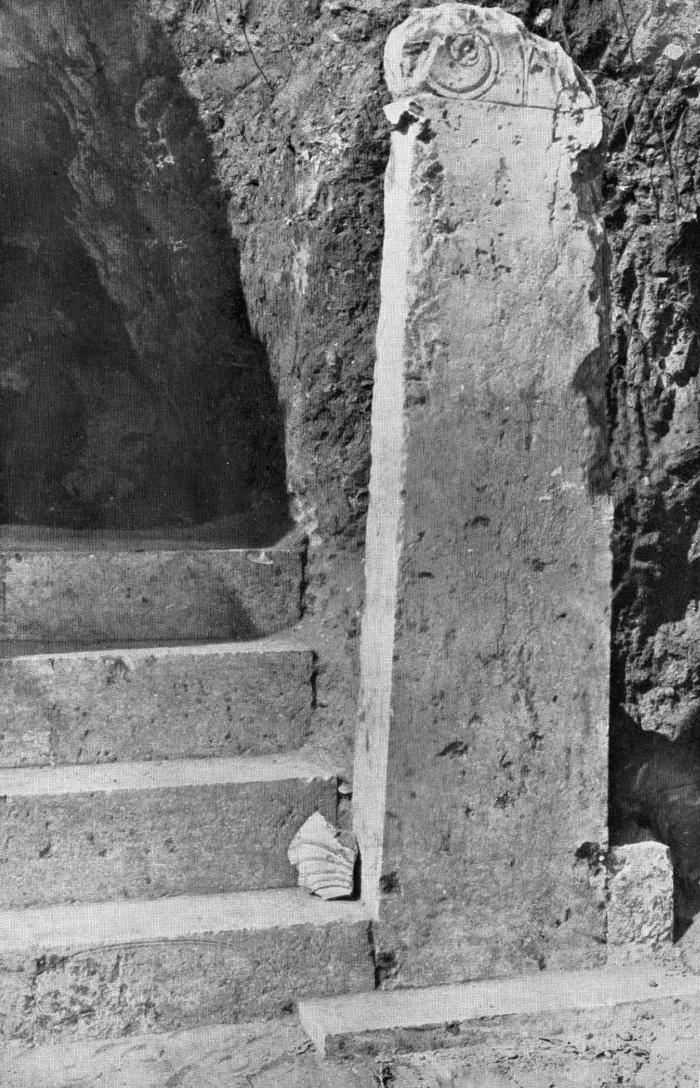Chamber Tomb Stele
- Date
- 520-480 BC, Late Lydian (Persian)
- Sardis or Museum Inv. No.
- S84.002
- Material
- Limestone, Stone
- Object Type
- Sculpture
- Sculpture Type
- Stele
- Site
- Sardis
- Sector
- Nec
- Trench
- Butler Tomb 813
- Locus
- Butler Tomb 813
- Findspot
- The stele was found in situ at Tomb 813 on the W bank of the Pactolus "on a very steep slope of the north side of the first hill" (ibid.). In front of the tomb entrance was a flight of steps composed of limestone blocks flanked at either end by one stele of the same material. "The entrance was probably faced with a wall and doorway, which were carried away . . . after the steps and stelae had become buried in earth" (ibid., 160). One of the stelai "preserved a part of its ornamental acroterion" (ibid., 116). As Butler's photograph shows, the stele was set into the lowest step and had a low base of its own attached in front.
- Description
The plain shaft rises from a simple low rectangular base. The proportion of shaft H. to W. is 4:1. Unlike Cat. 45 and Cat. 46 (Figs. 148-151) the convex volutes rose from two central stems; the eye was an elaborate plastic rosette. A thin, "manneristic" downward pointed lotus separated the rosettes; only the central leaf is preserved. The central design and elaborate eye appear on a limestone stele of Buschor's "Post-Polycratean" group, 520-500 B.C.; the palmette leaves, on his Polycratean group, 530-520 B.C. (Grabstelen, 34-35, no. V:2, Beil. XIV.1; 32-33, Beil. XI-XII). The stylistic date is ca. 520-500 B.C., as Friis-Johansen (Attic Grave-Reliefs, 74, n. 3) had suggested.
There is, however, hitherto neglected dating evidence from the objects found in the chamber tomb. "The chamber ... contained four sarcophagi of limestone . . . I believe the tomb was entered at an early date . . . Some pottery was found intact and a few gold objects hidden under deep layers of earth" (Sardis I, 160, ills. 177-178; pottery ill. 124). "The sarcophagus sunk into the floor . . . contained the bones of a large man, his gold ring and his seal ... , (ibid., 116).
Among the vases was a black-figure oinochoe (Butler no. P 1373), now lost (Beazley, Attic Black-Figure, 533, no. 10, "The Class of Vatican G 49," ca. 500-480 B.C. The gold objects (Sardis XIII, 14, no. 12, pl. 2:3; 39-40, no. 104, inv. no. 4581, pls. 10:1, 11:20) include lotus-palmette rosettes, rather similar to stelai Cat. 45 and Cat. 46 and an Achaemenid "court style" cylinder seal with king (or "hero") with two winged lions and two bearded sphinxes -- less closely datable (late 6th through 5th C. B.C.?) than the Attic oinochoe. E. Porada (by letter) suggests "probably late Darius."
While it is possible to argue that the tomb was cut and stelai erected before the latest burial, it may be safer to put the stele into the early 5th C. B.C.
- Condition
Limestone.
The drawing of the "actual state" (Sardis I, 161, ill. 178, here Fig. 153) indicates that the stele was broken across the top; a palmette fragment lying next to the stele (ibid., ill. 122, here Fig. 154) seems to belong. The second stele was also broken at the top. "The stelae retained traces of painted ornamental borders and probably bore painted inscriptions which have disappeared" (ibid., 116).
- Dimensions
- Scaled off from Butler's plan (Fig. 153) and elevation drawing, P.H. would be ca. 3; shaft H. ca. 2.20; W. ca. 0.65; W. of shallow base ca. 1.00; H. of base ca. 0.15 (?).
- Comments
- See Also
- Bibliography
- Published: Sardis I, 116, 159-160, ills. 122, 177, 178; Buschor, Grabstelen, 23; Friis-Johansen, Attic Grave-Reliefs, 74, n. 3; E. Pfuhl, Lydisch-Griechische Grabstele, 65; Borchhardt, Epichorsche Reliefs, 174f.; Hanfmann, Stelai, 36, 42, 44, figs. 3-4 (H-45).
- Author
- GMAH


